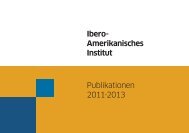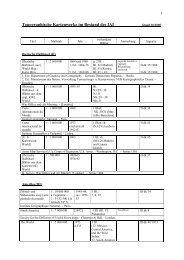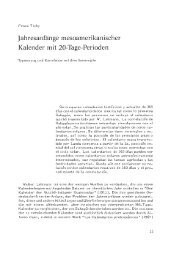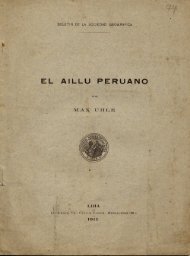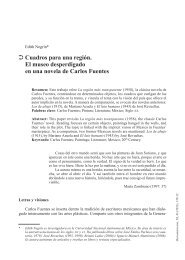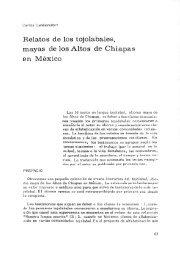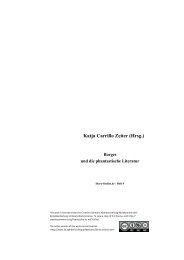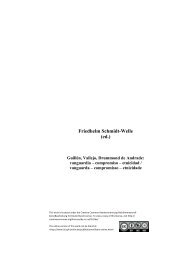The Mennonite Colonies in Paraguay. Origin - Ibero-Amerikanisches ...
The Mennonite Colonies in Paraguay. Origin - Ibero-Amerikanisches ...
The Mennonite Colonies in Paraguay. Origin - Ibero-Amerikanisches ...
You also want an ePaper? Increase the reach of your titles
YUMPU automatically turns print PDFs into web optimized ePapers that Google loves.
most of which was shipped by boat to Asunción, and the sell<strong>in</strong>g of fence poles, which were exported<br />
to Uruguay.<br />
From 1960, the colony was receiv<strong>in</strong>g outside assistance of major significance. An organisation of<br />
North American <strong>Mennonite</strong> bus<strong>in</strong>essmen known as MEDA (<strong>Mennonite</strong> Economic Development Associates)<br />
had <strong>in</strong>terested itself <strong>in</strong> provid<strong>in</strong>g adm<strong>in</strong>istrative advice, f<strong>in</strong>ancial support, and expert personnel<br />
<strong>in</strong> an effort to reorganise the colony and stabilise it economically. 18<br />
20<br />
Table 9: Data show<strong>in</strong>g the development of the colony of Volendam (1948-1958)<br />
<strong>Ibero</strong>-Bibliographien 5<br />
1948 1953 1958<br />
Villages 12 15 13<br />
Inhabitants 1,172 1,683 1,067<br />
Families 295 403 253<br />
Farms 295 397 241<br />
Crops planted (ha)<br />
Corn 49.8 187.8 282.1<br />
Kaffir 42.9 271.6 52.6<br />
Trees planted (number)<br />
Fruit trees n.d. n.d. 6,814<br />
Shade trees n.d. n.d. 1,701<br />
Domestic animals<br />
Horses 307 846 582<br />
Cattle 514 2,779 6,951<br />
Pigs 110 998 385<br />
Chickens 1,697 8,538 7,405<br />
Farm implements<br />
Farm wagons 42 246 145<br />
Buggies n.d. 0 25<br />
Plows 48 n.d. 167<br />
Harrows 6 n.d 87<br />
Cultivators 1 n.d. 158<br />
Source: Fretz (1962: 64, 65).<br />
2.2.3 Bergthal and Sommerfeld<br />
Although Bergthal and Sommerfeld were separate colonies, the members mak<strong>in</strong>g up the two groups<br />
came to <strong>Paraguay</strong> on the same ship and planned their immigration and colonisation ventures cooperatively.<br />
Bergthal and Sommerfeld were the most recent of the seven <strong>Mennonite</strong> colonies established <strong>in</strong><br />
<strong>Paraguay</strong> up to 1960s. Accord<strong>in</strong>g to Fretz, they constituted the most socially and religiously conservative<br />
element of the seven <strong>Mennonite</strong> colonies.<br />
In contrast to the colonies Fernheim, Neuland, Friesland and Volendam, the Bergthal and Sommerfeld<br />
colonists did not come to <strong>Paraguay</strong> as penniless refugees. Like the migrants who came 20 years<br />
earlier, they deliberately chose to come to <strong>Paraguay</strong>. When the <strong>Mennonite</strong> colonists left Canada <strong>in</strong><br />
1926 to settle <strong>in</strong> <strong>Paraguay</strong>, where they felt their religious freedom would be unmolested, some of their<br />
co-religionists decided to rema<strong>in</strong> <strong>in</strong> Canada. By 1948, however, they also had come to the conclusion<br />
that their way of life was be<strong>in</strong>g threatened by encroach<strong>in</strong>g secularism and so decided to migrate.<br />
Rather than settl<strong>in</strong>g <strong>in</strong> the Chaco, they decided to locate <strong>in</strong> Eastern <strong>Paraguay</strong>, where natural conditions<br />
looked more favourable.<br />
<strong>The</strong> Bergthaler and Sommerfelder, like the Menno colonists, were among the prosperous Canadian<br />
prairie farmers. <strong>The</strong>y had sold their farms at peak post-war prices and therefore had substantial sums<br />
<strong>in</strong> the bank. <strong>The</strong>y were also acqua<strong>in</strong>ted with mechanised farm<strong>in</strong>g and aspects of scientific agriculture.<br />
Thirteen tractors and a large bulldozer were among the first pieces of equipment brought along on the<br />
<strong>in</strong>itial migratory trip. <strong>The</strong> social solidarity of the groups was reflected <strong>in</strong> a fund that was raised to assist<br />
the poorer members.<br />
18 <strong>The</strong> section on Volendam is based on Fretz (1962: 61-66), Mueller (1998: 68-69), and Quir<strong>in</strong>g (1954: 302).



